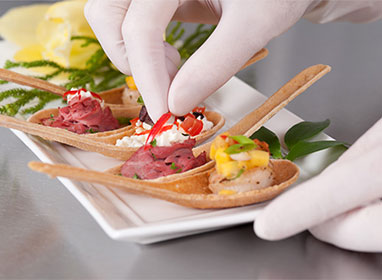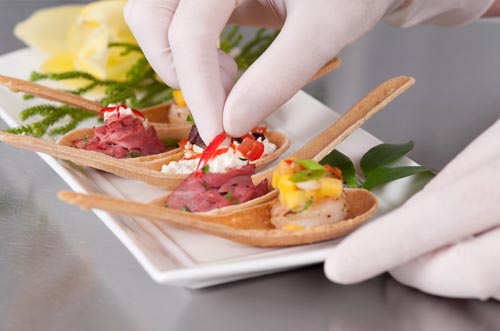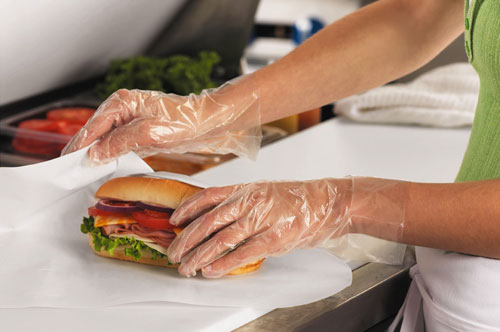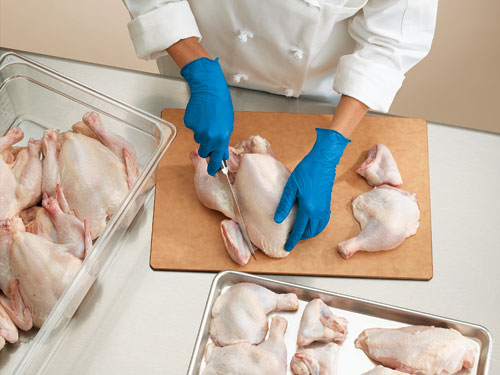
Choosing Foodservice Gloves - Disposable Gloves for the Bakery, Deli, Buffet and Kitchen
Some of the most common problems with injury and sanitation in industrial kitchens could be remedied with proper foodservice glove use. The U.S. Bureau of Labor Statistics noted that more than half (56.7%) of foodservice workers injured on the job sustained cuts, burns, strains, or sprains. This number is not insignificant, either: the number of foodservice workers injured was 67,160. While foodservice gloves cannot help with strains or sprains, proper glove usage can minimize or eliminate injuries from cuts or burns.

Additionally, proper glove usage can ensure proper accordance with food sanitation requirements. For example, New York state requires that foodservice workers do not use bare hands when handling any ready-to-eat foods. The foods covered under this requirement range from sandwiches and baked goods to ice and garnishes. While there are other ways to meet the ready-to-eat food handling requirements, the simplest method, again, is through proper disposable glove use.
Different food preparation and handling tasks require different types of gloves. Here, we’ll describe the proper gloves for preparing food:
Bakery
In a bakery, employees must navigate the handling of cooled products and removing hot products from ovens. If you need to regularly change your foodservice gloves, a poly glove is your best choice. Embossed Poly Gloves are inexpensive, easy to put on and take off, and come in packaging that makes them easy to store behind the counter.
If you are handling hotter foods latex gloves can prevent burns. Latex gloves are often used for unloading or loading ovens, or moving hot items, like cookies, from one spot to another. They are also used in chemical handling. The only problem with this alternative is that they are more expensive than poly gloves, meaning that you will likely only want to use them for necessary tasks. Additionally, some people do have latex allergies. If that is a concern for you, vinyl gloves can replace latex for tasks involving heat.

Deli
Foodservice gloves need to be changed regularly when working in a deli, making sandwiches or dishing out sides. Poly gloves are especially well suited to deli tasks, like portioning meats and cheeses and waiting on customers. Alternatives to poly gloves include Synthetic Poly gloves which give you touch sensitivity for tasks that require greater precision.
Buffet line
Buffet lines are particularly susceptible to spreading disease, making it even more important to wear disposable gloves when preparing or serving buffet-style foods. As always, be sure to wash your hands before putting on your gloves – yes, even if you are wearing gloves, you should still wash your hands – as well as after removing gloves.
When preparing foods, buffet workers often need gloves that provide touch sensitivity and dexterity. Powder Free Vinyl Gloves, for example, help workers grip foods properly, even if they are wet or slippery. To serve ready-to-eat foods often offered in buffets, workers must wear single-use gloves. Easily disposable and efficient to slip on and off, poly gloves work well for this purpose. However, if employees are serving hot foods with tongs, spoons, or spatulas, they likely should wear latex gloves to prevent burning themselves on chafing dishes.
Commercial kitchen
Working in a commercial kitchen means that you’ll be performing high-risk tasks, like cutting meat, in combination with duties that have less risk involved, like preparing sauces.
If you are at risk for knife injury, you don’t want to injure yourself by “undergloving.” Instead, wear a Nitrile Glove that is formfitting and more resistant to knife punctures than gloves made of vinyl or latex are. With these gloves, you’ll be able to perform complex knifework with less worry about injuring yourself.
For other types of tasks, you don’t want to “overglove,” or use gloves that are pricier than the task requires. For example, you don’t want to use a nitrile glove for straightforward tasks. Still, you want to choose a glove that offers grip and precision. A textured latex glove is a good choice for tasks that require precision—like, for example, tying roasts—and flexibility.

Remember, though, no matter what foodservice gloves you are wearing, always change your gloves when preparing a new type of food to avoid cross contamination. Additionally, if you are interrupted or four hours have passed—whichever comes first—you must switch out your gloves.